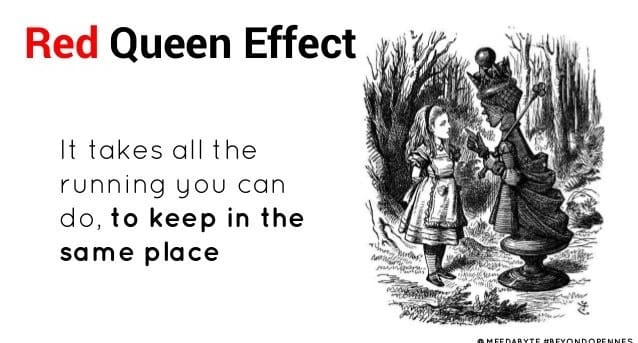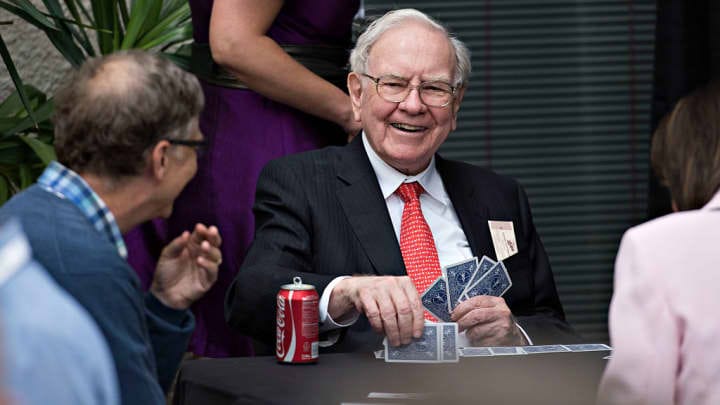- The Saturday Shareholder
- Posts
- Warren Buffett On How To Overcome The Most Difficult Part Of Investing
Warren Buffett On How To Overcome The Most Difficult Part Of Investing
The "Red Queen Effect"
Read Time: 6-minutes
A big thank you to our sponsor for helping keep this newsletter free to the reader:
Money Wisdom focuses on the engine behind your investment portfolio: your income, spending, & savings habits. Money Wisdom shares top money strategies, principles, & frameworks to help you grow your investment portfolio and achieve financial freedom.
Today, we’re going to look at:
Warren Buffett on how to overcome the most difficult part of investing, by way of a story about New York Times bestselling author & financial journalist Michael Lewis' publishing habit.
A mental model called "The Red Queen Effect" & 3 ways it impacts our investing.
Insights from Arthur Schopenhauer on the importance of quality learning over quantity, Naval Ravikant on optimizing for independence, & Nobel Prize Winner Francis Crick on the secret to winning.
Let’s get started.
1. Story
“Michael Lewis published his first book, Liar’s Poker, in 1989. It was a huge hit. But his next book didn’t come for another decade. He later explained his hiatuses and why he fills his time with hobbies:
‘Writers can get in this mindset where they feel they have to write another book … the publisher’s on you afterwards and they’re ready to get you going again. And I just always feel that the book is going to be better if I start all over again, start completely fresh as if I’ve never written a book before and give myself at least the option of not writing books.’
The best ideas happen when you wait patiently for them to come, which isn’t something you or your boss can schedule.”
The same could be said for investors, as Charlie Munger explains:
“It's waiting that helps you as an investor, and a lot of people just can't stand to wait. If you didn't get the deferred-gratification gene, you've got to work very hard to overcome that."
And Warren Buffett:
“We find doing nothing the most difficult task of all.”
— Warren Buffett
— Investment Wisdom (@InvestingCanons)
11:40 PM • Sep 18, 2024
Action bias is a common tendency where we prefer to take action over inaction—which can lead to less than superior decision-making.
When, as Lewis put it, you "give yourself the option of not" doing something, like needing to invest in another stock, you give yourself the freedom to maintain your standards.
You act from a position of strength. Rather than trying to force something to work.
But how can we train ourselves to improve at "doing nothing"?
3 tactics to consider:
1. Re-defining Action
If we define action as opening a new position on a new stock, not doing that is going to be pretty challenging.
But what if we define action as following our process, as doing the activities we know build a sound process:
Things like:
Deeply thinking through a company’s competitive advantage.
Learning about a company’s competitors.
Getting feedback from an investing partner.
Then, we'll always feel like we're taking action.
Buffett with some related wisdom:
"Before looking at new investments, we consider adding to old ones. If a business is attractive enough to buy once, it may well pay to repeat the process."
— Warren Buffett
— Investment Wisdom (@InvestingCanons)
4:56 AM • Nov 7, 2024
2. Distracting Ourselves
Warren Buffett is said to play at least 8 hours of Bridge per week—and he's shared there are days & even weeks without any meetings on his schedule.
Simply put, if we distract ourselves from feeling the need to overtrade, we'll probably improve our results.
3. Using A “20-Hole Punch Card”
Another tactic from Buffett is his "20 punch card" thought exercise. At a speech at Georgetown University, Buffett explained:
"In fact, I've told students if when they got out of school, they got a punch card with 20 punches on it, and that's all the investment decisions they got to make in their entire life, they would get very rich because they would think very hard about each one."
20 investments might not seem like a lot, but we don't need a lot, as Peter Lynch explained:
“You only need one or two good stocks a decade. You don't need a lot of action.”
— Peter Lynch
— Investment Wisdom (@InvestingCanons)
1:02 AM • Aug 20, 2024
If we focus on 20 high-conviction ideas, we become much more selective—and patient in the process.
2. Mental Model
"You must know the big ideas in the big disciplines and use them routinely — all of them, not just a few.” — Charlie Munger
Perhaps one of the reasons we're susceptible to Action Bias is the Red Queen Effect. This mental model comes from the discipline of evolutionary biology & has enormous importance for investing & business.
The Red Queen Effect describes situations where individuals, companies, or organizations must constantly adapt, improve, and/or evolve—to simply keep up with the competition.

The term Red Queen Effect comes from the classic story of Through The Looking Glass by Lewis Carroll.
The Red Queen explains to Alice:
"Now, here, you see, it takes all the running you can do, to keep in the same place."
3 applications of The Red Queen Effect for investing:
1. Competitive Advantage Erosion
When a company builds a competitive advantage & begins to earn above-average returns, of course, it naturally attracts competition.
Even companies with seemingly strong competitive advantages today are vulnerable to competitors tomorrow. So, management must be willing to continue to invest to at least maintain its position. Buffett explains:
“The key to investing is not assessing how much an industry is going to affect society, or how much it will grow, but rather determining the competitive advantage of any given company and, above all, the durability of that advantage.”
— Warren Buffett
— Investment Wisdom (@InvestingCanons)
9:33 PM • Oct 25, 2024
2. Industry Dynamics
Certain industries are subject to the Red Queen Effect more than others. They have to invest heavily just to remain competitive among similar peers. Buffett even got a taste of this with Berkshire in the textile industry. From Buffett's 1985 letter to shareholders:
“Over the years, we had the option of making large capital expenditures in the textile operation that would have allowed us to somewhat reduce variable costs. Each proposal to do so looked like an immediate winner. Measured by standard return-on-investment tests, in fact, these proposals usually promised greater economic benefits than would have resulted from comparable expenditures in our highly-profitable candy and newspaper businesses.
But the promised benefits from these textile investments were illusory. Many of our competitors, both domestic and foreign, were stepping up to the same kind of expenditures and, once enough companies did so, their reduced costs became the baseline for reduced prices industrywide. Viewed individually, each company’s capital investment decision appeared cost-effective and rational; viewed collectively, the decisions neutralized each other and were irrational (just as happens when each person watching a parade decides he can see a little better if he stands on tiptoes). After each round of investment, all the players had more money in the game and returns remained anemic.”
The lesson, as we've covered before, is to prioritize companies with pricing power.
3. Market Efficiency
Even in our role as investors, we face the Red Queen Effect with our peers. As other investors become more sophisticated, through technology and/or strategies, we must adapt to at least keep our competitive position.
The only way to get ahead is to keep learning. As Munger has explained:
"You are not going to get very far in life based on what you already know."
"Keep learning, that's the secret."
— Charlie Munger
— Investment Wisdom (@InvestingCanons)
11:52 PM • Aug 15, 2024
3. Insights
Quality of knowledge over quantity:
“You may accumulate a vast amount of knowledge but it will be of far less value to you than a much smaller amount if you have not thought it over for yourself; because only through ordering what you know by comparing every truth with every other truth can you take complete possession of your knowledge and get it into your power."
Optimizing for independence:
“Whenever you can in life, optimize for independence rather than pay. If you have independence and you’re accountable on your output, as opposed to your input – that’s the dream.”
The secret to winning (h/t @farnamstreet)
"Oh it’s very simple. My secret had been I know what to ignore."
Key Takeaways:
As Buffett explained, the most difficult thing for an investor to do is nothing. This is because of what's referred to as "Action Bias," or our preference to take action over inaction. Unfortunately, inaction may often serve us better.
3 ways to combat this common bias:
Re-define action: rather than thinking about "action" as starting a new investing position, define it as taking the next step in our process.
Use distraction: even Buffett gets away from his investment process to clear his mind & prevent overtrading.
Imagine a 20-hole punch card: Buffett encourages investors to imagine having a punch card with only 20-lifetime punches, each representing a new investment. He believes that kind of selectivity is what will make us rich.
Well, that’s all for this week
I hope you enjoyed these lessons.
See you next Saturday.
Two resources I think you might like:
Book Summaries: One of the most important lessons from Charlie Munger is to strive to become a little bit wiser each day. To accelerate my learning on everything from investing & decision-making to negotiating & habit-building, I use Blinkist (Thank you to the Blinkist team as their affiliate program helps keep this newsletter free to the reader). Blinkist offers easily readable book summaries to help you get the most valuable ideas from the most popular books. You can check out Blinkist here.
Mental Exercises: To paraphrase Morgan Housel, the common factor among elite investors is they have complete control over the space in between their ears. Financial news networks and social media can create a lot of "noise" for investors. To stay focused and calm, I like to use Headspace (I don't receive any compensation from Headspace currently). Headspace offers mindset and breathing exercises to help you keep control over the space between your ears. You can check out Headspace here.
Disclaimers
This material is not investment advice. No responsibility for loss occasioned to any person or corporate body acting or refraining to act as a result of reading this material can be accepted by the publisher. Additional disclaimers here.
Worth Exploring:
Terry Smith: Nvidia, Banks, & The UK market
Howard Marks: Ownership Vs. Debt
Ben Carlson: The Curse Of Early Success
How helpful was today's topic? |
P.S. Is there another topic(s) you would like me to cover? If so, reply to this email & let me know—I read & respond to ALL emails.
